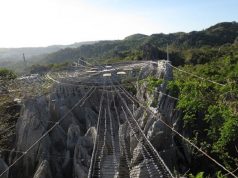
Filipino artist Westdon Martin Abay, popularly known as Dong Abay, recalled how he protested against the cutting of trees in Baguio back in 2012, implying that the lost forest cover could have protected the city.
The onslaught of Typhoon Ompong caused a trail of destruction in many parts of northern Luzon, particularly in Benguet.
While environmental experts have yet to attribute the incident to the cutting down of trees in the area, Abay conveyed how the loss of trees could have prevented or reduced the devastation in the province.
In his post, the former musician shared a throwback photo showing him tied to a tree on Baguio City’s Session Road.
“Pagkatapos ng bagyong si Ompong, siguro’y alam nyo na ngayon kung ano ang ipinaglalaban ko,” he said in Facebook post.

It was in protest of the expansion of a shopping center in the summer capital, as it will result in the loss of pine trees on Luneta Hill or Hill Station. His protest was not a welcome one for many.
It was also eventually a lost cause, as more than 100 trees were reportedly taken down in January 2015.
Abay is the former vocalist and song writer of a now-defunct Filipino rock band called Yano and now runs the small-scale agency Dong Abay Music Organization.
Facing the consequences
Without enough trees, the slopes of hills, mountains and plateaus are vulnerable to soil erosion, thus causing landslides.
“When the ground becomes saturated, it can become unstable, losing its equilibrium in the long run. That’s when a landslide breaks loose,” Earth Eclipse explained.
Another human activity that is considered to enable landslides is mining as it weakens soil materials, which eventually trigger landslides.
The country needs 54 percent of its forests to protect itself against natural disasters, Haribon Foundation forester Thaddeus Martinez told Philstar.com in an interview, aside from ensuring water sustainability.
However, our once-lush forest cover is rapidly declining at an alarming rate of 47,000 hectares per year, according to data from the Forest Management Bureau of the Department of Environment and Natural Resources.
The philippines’ forest cover is rapidly declining at an alarming rate of 47,000 hectares per year.
In 2011, the FMB launched the National Greening Program to rehabilitate the denuded forests. In the latest report, a total of 1.6 million hectares of forest lands have been restored.
Some local governments are also strictly implementing the Revised Presidential Decree 389 or the Forestry Reform Code of the Philippines.
Section 20 of the law states that “no person may utilize, exploit, occupy, possess or conduct any activity within any forest land, or establish and operate any wood-processing plant, unless he has been authorized to do so under a license agreement, lease, license, or permit.”









